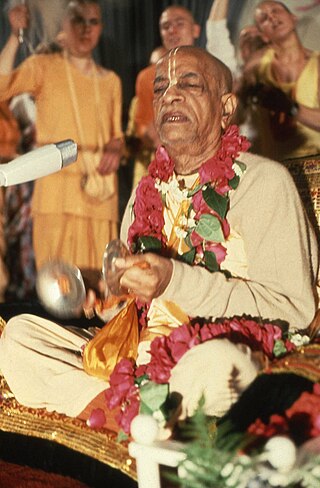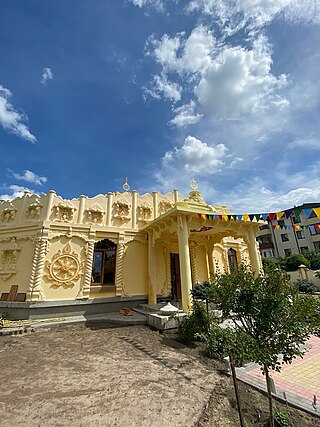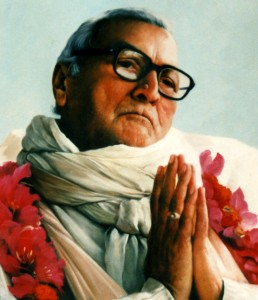
Abhay Charanaravinda Bhaktivedanta Swami Prabhupada was an Indian Hindu spiritual teacher who was the founder of the International Society for Krishna Consciousness (ISKCON), commonly known as the Hare Krishna movement. Followers of ISKCON view Bhaktivedanta Swami Prabhupada as a representative and messenger of Chaitanya Mahaprabhu.
The following outline is provided as an overview of and topical guide to Hinduism:

The International Society for Krishna Consciousness (ISKCON), known colloquially as the Hare Krishna movement, is a Gaudiya Vaishnava Hindu religious organization. It was founded on 13 July 1966 in New York City by A. C. Bhaktivedanta Swami Prabhupada. Its main headquarters is located today in West Bengal, India.

Chaitanya Mahaprabhu, born Vishvambhar Mishra, was a 15th-century Indian Hindu saint from Bengal who was the founder of Gaudiya Vaishnavism, which considers him to be an incarnation of Krishna.

Gaudiya Vaishnavism, also known as Chaitanya Vaishnavism, is a Vaishnava Hindu religious movement inspired by Chaitanya Mahaprabhu (1486–1534) in India. "Gaudiya" refers to the Gaura or Gauḍa region of Bengal, with Vaishnavism meaning "the worship of Vishnu". Specifically, it is part of Krishnaism—Krishna-centric Vaishnavite traditions.

The Gaudiya Math is a Gaudiya Vaishnava matha formed on 6 September 1920, about 30 months after Bhaktisiddhanta Sarasvati took sannyasa, the renounced order of life. On 7 March 1918, the same day he took sannyasa, he established the Sri Chaitanya Math in Mayapura in West Bengal, later recognised as the parent body of all the Gaudiya Math branches. Its purpose was to spread Gaudiya Vaishnavism, the philosophy of the medieval Vaisnava saint Chaitanya Mahaprabhu, through preaching and publishing.

Hinduism is a minor religious faith in Finland.

Hinduism is a minority religion constituting about 0.15% of the population of Austria. Hinduism is not one of the 16 recognised religions in Austria. The Austrian law allows religious groups not recognized as societies to seek official status as confessional communities with the Office for Religious Affairs. Hinduism is one of the eight confessional communities in Austria. However, the Sahaja Yoga and the International Society for Krishna Consciousness are categorised as associations, not as confessional communities.

Hinduism in Mongolia is a minority religion; it has few followers and only began to appear in Mongolia in the late twentieth century. According to the 2010 and 2011 Mongolian census, the majority of people that identify as religious follow Buddhism (86%), Shamanism (4.7), Islam (4.9%) or Christianity (3.5). Only 0.5% of the population follow other religions.

Hinduism is a minority religion in Ukraine. It is followed by 0.1% of the population, with a slightly higher proportion in Western Ukraine (0.2%).

Hinduism is a minority religion in Slovenia. ISKCON was registered in Slovenia in 1983 and The Hindu Religious Community in Slovenia was registered in 2003 in Ljubljana

Hinduism in Poland is a minority religion. Hinduism has spread to Poland through ISKCON since 1976. First groups of Polish devotees were established in Warsaw and Wrocław. The first Polish Hindu temple was established in 1980 in Czarnów, Lower Silesian Voivodeship. Main ISKCON temple is New Ramana Reti Temple in Mysiadło.
Hindu denominations, sampradayas, traditions, movements, and sects are traditions and sub-traditions within Hinduism centered on one or more gods or goddesses, such as Vishnu, Shiva, Shakti and so on. The term sampradaya is used for branches with a particular founder-guru with a particular philosophy.

Bijoy Krishna Goswami, also known by the honorific Gosaiji, was a Hindu social reformer and religious figure in India during the British period.

Hinduism is a minority faith in Brazil followed by approximately 0.01% of its population. Hinduism in Brazil is represented mainly by Ananda Marga, Brahma Kumaris and the Osho Institute Brazil, ISKCON, Yoga In Bound, Brasil Gaudiya Math and Sri Chaitanya Saraswat Math e Organização Vrinda de Paramadweit. The vedic astrology is also becoming popular due to Academia Brasileira de Astrologia Védica.

Bhakti Rakshak Sridhar was an Indian guru, writer, sannyasi and spiritual leader in the Gaudiya Vaishnava tradition of Chaitanya Mahaprabhu, founder-president-acharya of the Sri Chaitanya Saraswat Math.
Bhakti Marga is a neo-Hindu organisation founded by the Mauritian-born guru Vishwananda. It views itself as being part of a new tradition founded by Vishwananda, the Hari Bhakta Sampradaya, which represents a combination of certain Vaishnava, Shaiva and Shakta philosophies. The followers do not adhere to one particular set of scriptures or philosophy but rather on the "personality of Paramahamsa Vishwananda", similar to the Sant tradition.




















